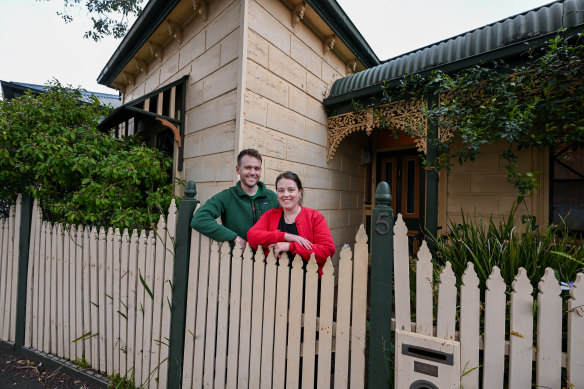This was published 1 year ago
Most Melbourne suburbs are unaffordable for home buyers. Except these
By Jim Malo and Melissa Heagney-Bayliss
Only one suburb in Melbourne is considered affordable for single home buyers earning an average income and hoping to avoid mortgage stress.
Couples would have more options, but would be forced to choose a house further from the city or a unit closer in, due to high interest rates and rising property prices.
The unicorn suburb for single buyers is Carlton, where the median unit price is $310,500 and investor-grade student accommodation abounds.
Based on official data measuring average weekly earnings, someone who is paid $95,300 a year could borrow enough to buy a home worth up to $333,600, Canstar analysis showed.
That assumes they have a 20 per cent deposit and cap their mortgage repayments at 30 per cent of income – the threshold for housing stress.
Home buyers could borrow more, if they accept the pressure it would place on the household budget.
Removing the housing stress test, that person would qualify to buy a $435,600 home, which made the typical unit in 11 suburbs accessible, including Epping, Sunshine and Brunswick West. There are no suburbs where the typical house was affordable to a single person on an average income.
Buyers could choose a below-average home in more expensive suburbs, but it would likely be smaller or lower quality.
Canstar group executive Steve Mickenbecker said it was easier for dual-income couples, who could buy a $668,400 home without being in housing stress.
“It’s a whole different ball game. The whole aspect of first homeownership becomes viable,” he said.
“Singles are really up against it, though.”
Suburbs within that budget, based on a combined, average gross income, included Sunbury, Lalor and Mernda. There were 48 suburbs considered affordable.
“You might be able to get a house somewhere out of town, but it’s not viable [otherwise],” Mickenbecker said. “You could get a unit pretty much anywhere, though.”
It comes as the Victorian government this week unveiled plans to build 800,000 homes over a decade in response to the housing crisis.
Buyers on a budget said they had to make more compromises than ever, partially due to high interest rates.
Jamie Lynn and Tess Medew-Ewen, both 33, bought their first home just last week.
“We’ve rented our whole lives, in inner Melbourne for most of that time, so we were hoping to find something around here even if it was an apartment,” Lynn said. “But what was available just wasn’t suitable.
“We had to move a bit further out than what we initially thought,” Lynn said. The couple is moving to Hadfield, where they already have friends.

Jamie Lynn and Tess Medew-Ewen are moving out of their Kensington rental and have bought a home further from the city.Credit: Joe Armao
Medew-Ewen said their families kindly offered to help them buy, because they had found it difficult to afford to get into the market.
The couple now own a three-bedroom house with a front yard and space for their son.
The couple’s buyer’s advocate, Property Home Base’s Julie DeBondt-Barker, said the market had become tough for first home buyers, especially those who weren’t willing to make compromises about where or what they were going to buy.
“A lot of buyers aren’t adjusting, so they’re just not buying,” Debondt-Barker said. “The fallacy is that because interest rates have gone up, prices will go down, but because there’s not enough properties coming onto the market that’s just not happening.”
Calder Real Estate agent Mo Safatli sells in Melbourne’s western fringe; he said singles were hard-pressed to buy in suburbs like Delahey, Harkness or St Albans, and he mostly dealt with couples.
“If they’re going in together, yes, they can pay a bit more,” he said. “But a single person is more on a budget. First home buyer [couples] have a budget of about $600,000.”
Safatli said while most were already living in the west before they purchased, they would sometimes be pushed out of more expensive suburbs.
“They tend to have ventured out to the more fancy areas to rent and then come back due to affordability,” he said. “There’s a bit of both. They may have been brought up in, say, Footscray or Sunshine, and they can’t afford it there, so they venture out to the next suburb.”
Independent economist Saul Eslake said decades of failed housing policy had created an environment where most areas of major cities were unaffordable for those on average incomes.
“It’s always been the case that there are areas that have traditionally been for first home buyers, the urban fringes,” he said. “But even in those areas now, they’re beyond the reach of most people on average incomes.
“You almost always need two incomes to buy.”
Eslake said it was easier for average income earners with access to generational wealth.
“For those people who were sensible to pick their parents carefully, they have an advantage over those who didn’t,” he said.